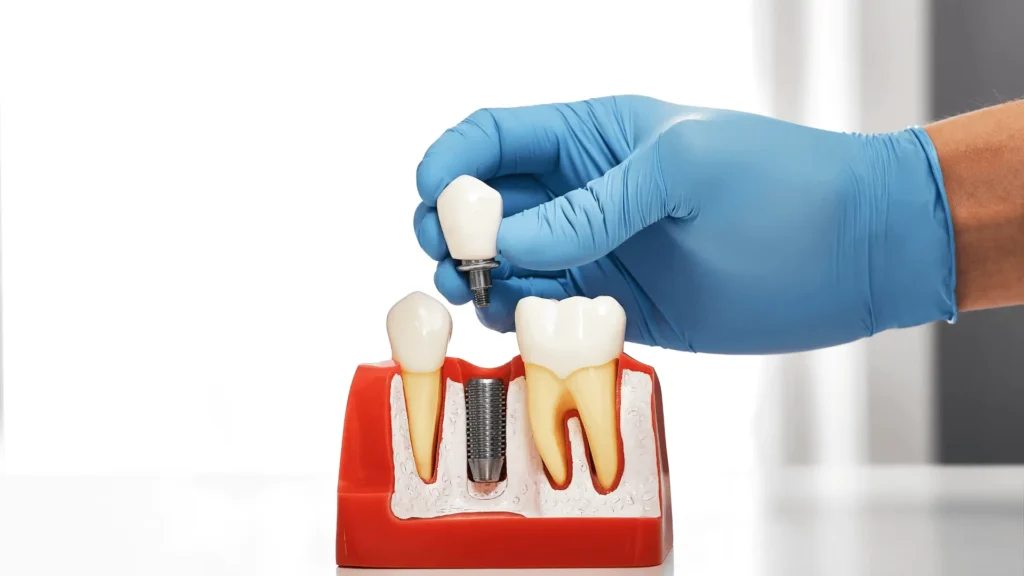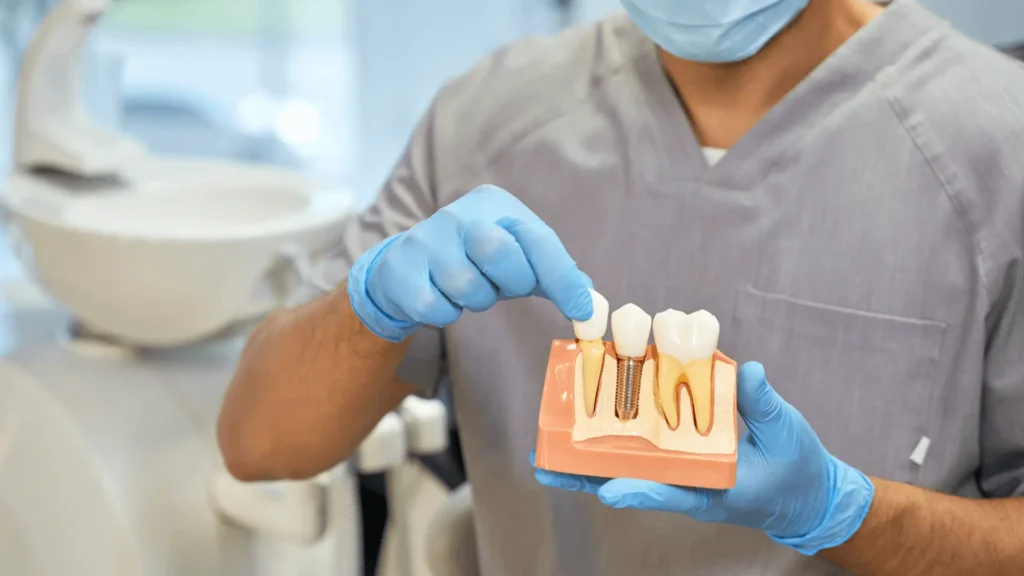Are Dental Implants Covered by Insurance | Clear Answers
Are Dental Implants Covered by Insurance, Dental implants may or may not be covered by your dental insurance provider, depending on your specific policy and the circumstances surrounding the need for implants. Generally, dental insurance plans are more likely to cover implants if they are required due to an accident or a medical condition, as opposed to purely cosmetic reasons.
Coverage often varies, with some policies covering a portion of the costs, typically ranging from 50% to 70%, while others may offer limited or no coverage at all. To determine if your dental insurance will cover the cost of implants, it’s essential to review your policy’s details. Look for terms such as “missing tooth clause,” annual maximums, waiting periods, and pre-approval requirements.
Understanding these aspects can help you navigate the insurance process and explore additional options for financing if your insurance falls short. By being informed and proactive, you can better manage the financial aspects of getting dental implants and ensure you receive the necessary care without undue financial stress.

What are Dental Implants?
Dental implants are artificial tooth roots made of titanium that are surgically inserted into the jawbone to support a replacement tooth or bridge. They provide a permanent base for fixed or removable replacement teeth, designed to match your natural teeth in both appearance and function.
Implants are a popular and effective long-term solution for people who suffer from missing teeth, failing teeth, or chronic dental problems. Because they integrate with the jawbone, they offer stable support for artificial teeth.
There are three main components of a dental implant:
Dental implants are a high-tech replacement tooth that mimics the whole tooth structure. They are the only dental restoration option that preserves and stimulates natural bone, helping stimulate bone growth and prevent bone loss.
When are Dental Implants Necessary?
Dental implants are necessary in several situations where you need to replace missing teeth or improve dental function. Here are some common scenarios when dental implants are considered:
Missing Teeth
If you have one or more missing teeth, dental implants can fill the gaps and restore your smile. Missing teeth can affect your bite and lead to other dental problems if not addressed.
Tooth Decay or Damage
When a tooth is severely decayed or damaged and cannot be saved through other treatments like fillings or crowns, a dental implant can provide a stable and long-lasting replacement.
Denture Support
If you wear dentures and find them uncomfortable or unstable, dental implants can be used to anchor the dentures securely in place. This helps prevent slipping and makes eating and speaking easier.
Bone Loss
Missing teeth can lead to bone loss in the jaw over time. Dental implants help stimulate the jawbone, preventing further bone deterioration and maintaining the structure of your face.
Infection or Disease
Teeth affected by severe periodontal disease or infection may need to be extracted and replaced with dental implants to restore oral health.
Improving Appearance and Confidence
Dental implants look and feel like natural teeth. They can enhance your appearance, boost your confidence, and provide a permanent solution that functions just like your natural teeth.
Improving Oral Function
If you have difficulty chewing or speaking due to missing teeth or poorly fitting dentures, dental implants can restore proper function, allowing you to eat your favorite foods and speak clearly.
Understanding Dental Insurance Coverage
Dental insurance can be complex, especially when it comes to understanding what procedures are covered. It’s essential to know the specifics of your plan to avoid unexpected costs. Here’s a breakdown of how dental insurance typically works and what it may cover:
Types of Dental Insurance Plans:
Preferred Provider Organizations (PPO)
These plans offer a network of dentists who have agreed to provide services at reduced rates. You can see any dentist, but you’ll pay less if you use in-network providers.
Health Maintenance Organizations (HMO)
These plans require you to choose a primary dentist from their network. You must get a referral to see a specialist.
Discount or Referral Dental Plans
These are not insurance but provide discounts on dental services when you use participating providers.
Common Coverage Categories:
Preventive Care
Most dental plans cover preventive services like cleanings, exams, and X-rays at 100%. This is to encourage regular check-ups and catch problems early.
Basic Procedures
These include fillings, extractions, and periodontal treatment. Insurance often covers 70-80% of the cost after the deductible.
Major Procedures
This category includes crowns, bridges, and dentures. Coverage is typically lower, around 50%, due to the higher cost of these services.
Annual Maximums
Dental insurance plans often have an annual maximum limit, which is the most they will pay for your care in a year. Once you reach this limit, you are responsible for any additional costs.
Waiting Periods
Some plans have waiting periods for certain procedures, especially major ones. This means you have to wait a specified period before the insurance covers these treatments.
Pre-existing Conditions
Some dental plans do not cover pre-existing conditions, meaning any dental issues you had before obtaining the insurance may not be covered.
Cosmetic Procedures
Most dental insurance plans do not cover cosmetic procedures, such as braces or teeth whitening and veneers, as they are not considered medically necessary.
Understanding your dental insurance coverage is crucial to making informed decisions about your dental care. Always review your policy details, and don’t hesitate to contact your insurance provider for clarification on what is covered under your plan. This knowledge can help you avoid unexpected expenses and ensure you receive the care you need.
Does medical insurance cover dental implants?

Medical insurance typically does not cover dental implants, as they are generally considered a dental procedure rather than a medical one. However, there are exceptions and specific situations where medical insurance may provide some coverage, like Chiropractic coverage.
Here’s what you need to know:
Dental vs. Medical Insurance:
Dental Insurance: Dental insurance is designed to cover routine dental care and procedures, including preventive care, fillings, and sometimes major procedures like crowns and implants.
Medical Insurance: Medical insurance covers treatments that are medically necessary, such as surgeries, hospital stays, and some outpatient services. Dental implants are usually not classified under medical necessity.
When Medical Insurance May Cover Dental Implants:
Accidents and Injuries: If you lose teeth due to an accident or injury, medical insurance might cover the cost of dental implants as part of the reconstructive surgery.
Medical Conditions: In some cases, if a medical condition necessitates the need for dental implants, such as oral cancer or a genetic condition that affects tooth development, medical insurance might cover part of the procedure.
Surgical Procedures: If the implant procedure involves surgery on the jawbone or other areas that cross into medical territory, part of the procedure might be covered by medical insurance.
Coverage Percentages:
Insurance coverage can vary widely. Some policies may only cover 50% of the cost, while others may cover up to 70%. It all depends on your particular policy and its terms. Reviewing your policy details is crucial to understand the extent of coverage for dental implants.
Coordination of Benefits:
In situations where both dental and medical insurance may provide coverage, it’s essential to understand how the coordination of benefits works. This means determining which insurance will be the primary payer and which will be secondary. Often, dental insurance will cover part of the procedure, and medical insurance may cover specific related costs.
Pre-authorization and Documentation:
Before undergoing dental implant surgery, it’s crucial to check with both your dental and medical insurance providers. Pre-authorization may be required, and detailed documentation from your dentist or oral surgeon will be necessary to support the claim that the procedure is medically necessary.
Out-of-Pocket Costs:
Even if some aspects of the implant procedure are covered by medical insurance, there may still be significant out-of-pocket costs. These can include co-pays, deductibles, and costs not covered by insurance.
While dental implants are primarily covered by dental insurance, there are specific scenarios where medical insurance might help with the costs. It’s important to thoroughly investigate your insurance policies, communicate with your providers, and plan accordingly to manage the expenses associated with dental implants.
How to save money on dental implants
Dental implants can be expensive, but there are several ways to manage the cost and make the procedure more affordable.
Here are some strategies to help you save money on dental implants, similar to how managing costs for pelvic floor therapy can involve multiple strategies.
Check Your Insurance Coverage:
Review both your dental and medical insurance policies to see if they cover any part of the dental implant procedure. Some dental insurance plans cover a portion of the cost, typically ranging from 50% to 70%. If the procedure is deemed medically necessary, your medical insurance might cover part of the expenses.
Shop Around for Prices:
Prices for dental implants can vary significantly between dental practices. Get quotes from several dentists to compare costs. Don’t be afraid to ask for a detailed breakdown of the charges so you can make an informed decision.
Consider Dental Schools:
Dental schools often offer implant procedures at a reduced cost. The work is performed by dental students under the supervision of experienced instructors. This can be a cost-effective way to receive high-quality care.
Look for Discount Plans:
Some discount dental plans offer reduced rates for dental procedures, including implants. These plans are not insurance but can provide significant savings if you use participating dentists.
Ask About Payment Plans:
Many dental offices offer financing options or payment plans to help spread the cost of implants over time. This can make the procedure more manageable by breaking the total cost into smaller, monthly payments.
Health Savings Accounts (HSAs) and Flexible Spending Accounts (FSAs):
If you have an HSA or FSA, you can use these funds to pay for dental implants. Contributions to these accounts are tax-free, which can help you save money on the procedure.
Dental implants can often be a significant investment, and while many people hope for insurance coverage, the extent of coverage can vary. Some insurance plans might include a portion of dental implant costs, but others consider it an elective procedure, making coverage less likely.
If you’re unsure, an insurance agent, with perfect qualities can provide clarity on your options, including whether gap insurance might help bridge any financial gaps. Additionally, considering retirement plan solutions and exploring coverage options like, Invisalign, LASIK eye surgery costs without insurance can help you plan for healthcare expenses in the long term, ensuring you’re prepared for a range of medical needs.
Negotiate with Your Dentist:
Don’t hesitate to discuss the cost with your dentist and see if there is any room for negotiation. Some dentists may offer discounts for upfront payments or provide a sliding scale based on your financial situation.
Consider Medical Tourism:
In some cases, traveling abroad for dental implants can be significantly cheaper, even when including travel expenses. Countries like Mexico, Thailand, and Hungary are popular destinations for affordable dental care. Ensure you research and choose reputable clinics with experienced dentists.
Use Care Credit:
CareCredit is a healthcare credit card designed to help pay for out-of-pocket healthcare expenses, including dental implants. It offers various financing options, including interest-free periods if paid within a specific timeframe.
Preventative Care:
Taking good care of your oral health can prevent the need for future dental implants. Regular dental check-ups, cleanings, and good oral hygiene practices can help you avoid tooth loss and the subsequent need for implants.
With these options and planning ahead, you can reduce the financial burden of dental implants and make the procedure more accessible.
Reasons for Lack of Coverage
Understanding why dental implants may not be covered by insurance can help you to understand your options and make informed decisions about your dental care. Here are the main reasons for the lack of coverage:
Classification as Cosmetic Procedure:
Many insurance companies classify dental implants as a cosmetic procedure rather than a medically necessary one. Since implants improve appearance, insurers often categorize them alongside elective treatments like teeth whitening, which are typically not covered.
High Cost of Implants:
Dental implants are expensive, involving surgery, materials, and multiple dental visits. Covering these costs can be financially burdensome for insurance companies, leading them to limit or exclude coverage for such procedures.
Insurance Policy Limits:
Dental insurance policies often have annual maximum limits on coverage, usually ranging from $1,000 to $1,500. Given the high cost of implants, these limits are quickly exceeded, leaving the remaining expenses to be paid out-of-pocket by the patient.
Focus on Preventive Care:
Dental insurance plans prioritize preventive care, such as cleanings, and exams, and basic procedures like fillings. The aim is to maintain oral health and prevent serious issues from developing. Because implants are often considered beyond basic care, they may not be included in standard coverage.
Waiting Periods:
Some dental insurance plans have waiting periods for major procedures, including implants. This means new policyholders must wait a certain period before their insurance covers these treatments. If implants are needed immediately, the waiting period can be a significant barrier.
Pre-existing Conditions:
Many insurance policies exclude coverage for pre-existing conditions, including missing teeth that existed before the policy began. If you need implants to replace teeth lost before obtaining your insurance, the procedure might not be covered.
Alternative Treatments:
Insurers often prefer less expensive alternatives to implants, such as dentures or bridges. These options, while not as long-lasting or effective as implants, are cheaper and more likely to be covered by insurance.
Varying Definitions of Medical Necessity:
What constitutes a medically necessary procedure can vary between insurance companies. While some may recognize implants as essential for oral health and function, others may not. This inconsistency leads to varying coverage policies.
Lack of Standardization:
Dental insurance policies are not standardized, and coverage can differ widely between providers and plans. This lack of standardization means that while one policy might cover implants, another might not, even within the same insurance company.
How to Use Your Dental Insurance to Pay for Implants
Dental insurance to cover the cost of dental implants can be challenging, but with careful planning and understanding of your policy, you can maximize your benefits.
Here are some steps to help you use your dental insurance to pay for implants:
Know What Plans Are Available to You:
Begin by exploring the different dental insurance plans available to you. Some plans may offer better coverage for implants than others. If you’re considering changing plans or purchasing new insurance, compare the benefits and coverage details of each option.
Explore Details and Limitations of Dental Plans That Cover Implants:
Not all dental insurance plans cover implants. Look for plans that specifically mention implant coverage. Understand the limitations and conditions, such as annual maximums and coverage percentages, to ensure you choose the best plan for your needs.
Review Your Insurance Policy:
Start by thoroughly reviewing your dental insurance policy. Look for information on coverage for major procedures, including implants, annual maximums, waiting periods, and exclusions for pre-existing conditions.
Check for Implant Coverage:
Some dental insurance plans offer partial coverage for implants. This might include the cost of the implant post, abutment, and crown. Coverage percentages can vary, with some policies covering 50% to 70% of the cost. Verify what parts of the procedure are covered and to what extent.
Missing Tooth Clause:
Some insurance policies have a “missing tooth clause,” which excludes coverage for teeth that were missing before the policy was in effect. Check if this clause applies to your plan, as it can affect coverage for implants.
Pre-Approval:
Before proceeding with the implant procedure, request a pre-treatment estimate from your dentist. This estimate should detail the costs involved and be submitted to your insurance company for pre-approval. The insurer will then provide an explanation of benefits (EOB), outlining what costs will be covered and what you will need to pay out-of-pocket.
Waiting Period:
Some dental insurance plans have waiting periods for major procedures, including implants. This means new policyholders must wait a certain period before their insurance covers these treatments. If implants are needed immediately, the waiting period can be a significant barrier.
Pre-existing Conditions:
Many insurance policies exclude coverage for pre-existing conditions, including missing teeth that existed before the policy began. If you need implants to replace teeth lost before obtaining your insurance, the procedure might not be covered.
Coordinate with Your Dentist:
Discuss your insurance coverage with your dentist. They can help by providing the necessary documentation and working with your insurance company to maximize your benefits. Some dental offices have staff dedicated to handling insurance claims and pre-authorizations.
Utilize Both Dental and Medical Insurance:
In some cases, aspects of the implant procedure may be covered by both dental and medical insurance. For example, if the implant is needed due to an injury, your medical insurance might cover a portion of the surgery. Coordinate benefits between your dental and medical insurance to reduce your out-of-pocket expenses.
Maximize Annual Benefits:
Dental insurance policies often have annual maximum limits. If your implant treatment can be spread over two calendar years, you can utilize two years’ worth of benefits, thereby increasing the amount covered by insurance. For example, have the implant post placed at the end of one year and the crown installed at the beginning of the next year.
Explore Payment Plans and Financing:
If your insurance does not cover the entire cost of the implants, ask your dental office about payment plans and financing options. Many dental practices offer financing through third-party companies like CareCredit, which can help you spread the cost over time.
Collect Required Documents for Payment Processing:
Ensure that all necessary documents, such as treatment plans, cost estimates, and medical necessity letters, are collected and submitted to your insurance provider. Proper documentation can streamline the payment process and help in case of disputes or appeals.
Submit Claims Promptly:
Ensure that all insurance claims are submitted promptly and accurately. Delays or errors in submission can lead to denied claims or reduced coverage. Keep copies of all correspondence and documentation related to your implant procedure and insurance claims.
Appeal Denied Claims:
If your insurance claim is denied, don’t give up. Contact your insurance provider to understand the reason for the denial and consider appealing the decision. Provide additional documentation or a letter from your dentist explaining the medical necessity of the implants.
Consider Supplemental Insurance:
If your current dental insurance does not provide sufficient coverage for implants, consider purchasing supplemental dental insurance. These plans can provide additional benefits specifically for major procedures, including implants.
What to Do if Dental Implants are Not Covered
If your dental insurance does not cover the cost of dental implants, there are still several options to make the procedure more affordable. One of the first steps is to discuss alternative payment options with your dentist. Many dental offices offer financing plans that allow you to spread the cost over several months or even years.
Additionally, third-party financing companies like CareCredit provide specialized healthcare credit cards with flexible payment options and promotional periods of zero interest. These alternatives can significantly ease the financial burden and make dental implants accessible without needing upfront payment.
Exploring external resources and assistance programs is another viable strategy. Some non-profit organizations and dental schools offer low-cost or sliding-scale fee structures for dental procedures, including implants. Medical tourism is also an option worth considering; countries like Mexico, Thailand, and Hungary provide high-quality dental care at a fraction of the cost in the U.S.
However, it’s crucial to thoroughly research and choose reputable clinics to ensure safety and quality. Furthermore, health savings accounts (HSAs) and flexible spending accounts (FSAs) can be utilized to pay for dental implants with pre-tax dollars, providing a substantial financial benefit.






